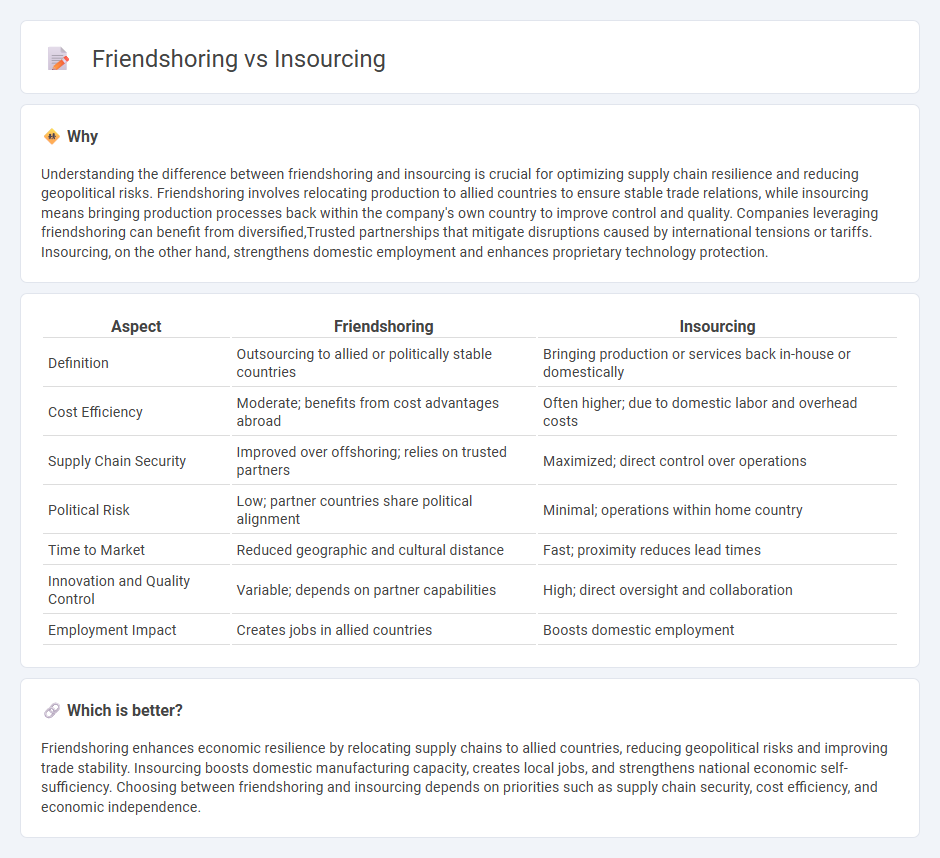
Friendshoring shifts supply chains to allied countries, enhancing economic security and reducing risks linked to geopolitical tensions. Insourcing brings manufacturing back domestically, boosting local employment and fostering innovation through closer oversight. Explore the economic impacts and strategic benefits of both approaches to understand their role in modern trade.
Why it is important
Understanding the difference between friendshoring and insourcing is crucial for optimizing supply chain resilience and reducing geopolitical risks. Friendshoring involves relocating production to allied countries to ensure stable trade relations, while insourcing means bringing production processes back within the company's own country to improve control and quality. Companies leveraging friendshoring can benefit from diversified,Trusted partnerships that mitigate disruptions caused by international tensions or tariffs. Insourcing, on the other hand, strengthens domestic employment and enhances proprietary technology protection.
Comparison Table
| Aspect | Friendshoring | Insourcing |
|---|---|---|
| Definition | Outsourcing to allied or politically stable countries | Bringing production or services back in-house or domestically |
| Cost Efficiency | Moderate; benefits from cost advantages abroad | Often higher; due to domestic labor and overhead costs |
| Supply Chain Security | Improved over offshoring; relies on trusted partners | Maximized; direct control over operations |
| Political Risk | Low; partner countries share political alignment | Minimal; operations within home country |
| Time to Market | Reduced geographic and cultural distance | Fast; proximity reduces lead times |
| Innovation and Quality Control | Variable; depends on partner capabilities | High; direct oversight and collaboration |
| Employment Impact | Creates jobs in allied countries | Boosts domestic employment |
Which is better?
Friendshoring enhances economic resilience by relocating supply chains to allied countries, reducing geopolitical risks and improving trade stability. Insourcing boosts domestic manufacturing capacity, creates local jobs, and strengthens national economic self-sufficiency. Choosing between friendshoring and insourcing depends on priorities such as supply chain security, cost efficiency, and economic independence.
Connection
Friendshoring and insourcing both aim to enhance supply chain resilience by relocating production closer to home or to allied nations, reducing dependency on distant or politically unstable regions. Friendshoring strategically shifts manufacturing to countries with strong diplomatic ties, fostering economic security and stable trade partnerships. Insourcing complements this by bringing previously outsourced operations back in-house or domestic, increasing control over quality and innovation while supporting local job creation.
Key Terms
Supply Chain
Insourcing involves bringing supply chain functions in-house to improve control and reduce dependency on external suppliers, enhancing agility and risk management. Friendshoring shifts supply chain operations to allied or politically stable countries to minimize disruptions caused by geopolitical tensions. Explore comprehensive strategies to determine which approach best strengthens your supply chain resilience.
Labor Cost
Insourcing involves relocating business operations internally, often within the same country, which can lead to higher labor costs due to local wage standards and benefits. Friendshoring shifts production to allied nations with favorable trade relationships, balancing moderate labor expenses and supply chain resilience. Discover how these strategies impact your company's bottom line and labor cost management.
Trade Policy
Insourcing involves relocating production within a company's home country to enhance control and reduce supply chain risks, aligning with protectionist trade policies that encourage domestic manufacturing. Friendshoring prioritizes shifting supply chains to allied or politically stable countries, promoting secure and reliable trade partnerships favored in contemporary trade agreements. Explore how these strategies impact global trade dynamics and policy frameworks in detail.
Source and External Links
What Is Insourcing and How It Works (With Examples) | Indeed.com - Insourcing is the process of recruiting outside individuals or reassigning teams from third parties into a company to build capacity and improve productivity, representing the opposite of outsourcing where work is given to outside entities.
What Is Insourcing? Definition, Benefits, And Examples - Insourcing means assigning tasks to internal departments or hires rather than outsourcing, allowing companies to maintain control, reduce costs, and leverage existing expertise for projects like manufacturing or IT services.
Insourcing - Definition, Examples & FAQ | Recruiteze - Insourcing involves using a company's own resources to perform a task previously outsourced by evaluating internal capabilities and implementing the task in-house, offering benefits such as better control, faster response, and enhanced collaboration compared to outsourcing.
 dowidth.com
dowidth.com